
Getty Images. Pictured: Christian McCaffrey, Saquon Barkley, Alvin Kamara
Sean Koerner — FantasyPros’ most-accurate draft ranker of 2019 — is breaking down his positional rankings and draft strategy for 2021. This series is part of our PRO subscription, which will not only grant you access to these Tiers, but also to his real-time rankings as part of our 2021 Fantasy Draft Kit.
Running back continues to be the most critical position in fantasy football.
There are two main reasons RB typically decides the fate of your team each season:
- As the NFL becomes an increasingly pass-heavy league and RBs are deployed for specific purposes, there are fewer workhorse backs. Positional scarcity makes it critical to draft at least two workhorse RBs.
- The position is very volatile. RBs are the most likely players to miss time due to injury, or to lose their job. Given the position is much more about opportunity rather than talent, it paves the way for late-round picks or even waiver wire pickups to emerge as league winners.
Because of those two factors, there are a lot of draft strategies focused solely on how many RBs you should acquire early on.
On the opposite end of the spectrum is the Zero RB strategy, which I agree with … in theory. It mainly focuses on Reason No. 2 above, but ignores Reason No. 1 — that’s why I would dub my approach as the RB Surplus Strategy: I first aim to draft two RBs before the end of Round 3/4 because, as I mentioned, it’s critical to acquire two who are set to open the season with a reliable workload. Then I target high-upside backs in the middle and late rounds.
Another important component of your draft strategy should be to understand the purpose of your bench. Generally, you don’t want to waste a bench slot on a quarterback or tight end — it’s very easy to find a replacement for either position on the waiver wire if you’re ever in a pinch or in need of a bye-week fill-in.
If I have seven bench slots, I’ll usually aim to fill them with two to three WRs and four to five high-upside RBs.
The goal of stashing high-upside RBs, specifically, is to hopefully strike gold if one earns a one-off start or becomes their team’s starter indefinitely. Think about the backup RBs who usually require a No. 1 waiver wire claim or the highest Free Agent Acquisition Budget (FAAB) bid to acquire when injury or depth chart news breaks mid-season — I can’t tell you how many times a RB who fits that profile was already on my bench.
Drafting RBs with the highest potential to be league winners allows me to be even more aggressive when I do have first priority on waiver wire claims or still have a high percentage of my FAAB available. To help you easily identify them, I’ve ranked backups by their upside here.
The chart below illustrates just how valuable the first handful of RBs drafted are — they offer such a significant edge over your leaguemates, hence why they’re typically the first four picks of the draft.
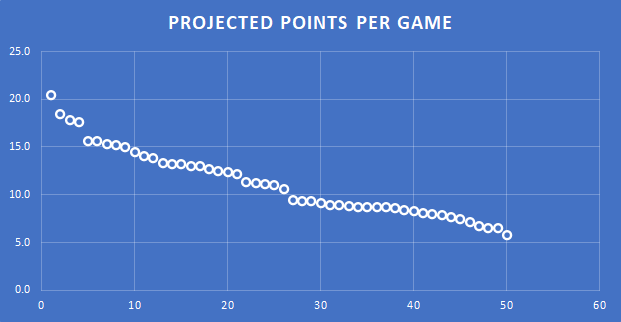
You can also see where the position features steep drop-offs. I aim to draft at least two RBs before the drop-off right outside the top 20, and three before the next drop off in the mid-20s.
Once a draft enters the RB30 range, your strategy depends on what type of RBs you’re looking for. That’s why, as part of these tiers, I attempted to create “buckets” that help you identify what exactly certain backs can offer you and when you’ll want to target them.
Let’s dive in!
Fantasy RB Rankings & Tiers
| Tier | Players |
|---|---|
| 1 | Christian McCaffrey (CAR) |
| 2 | Dalvin Cook (MIN) |
| 3 | Derrick Henry (TEN) Alvin Kamara (NO) |
| 4 | Ezekiel Elliott (DAL) Aaron Jones (GB) Austin Ekeler (LAC) Nick Chubb (CLE) Jonathan Taylor (IND) |
| 5 | Joe Mixon (CIN) Saquon Barkley (NYG) Antonio Gibson (WAS) |
| 6 | Clyde Edwards-Helaire (KC) Najee Harris (PIT) Chris Carson (SEA) D’Andre Swift (DET) David Montgomery (CHI) |
| 7 | J.K. Dobbins (BAL) Josh Jacobs (LV) Miles Sanders (PHI) Darrell Henderson (LAR) |
| 8 | Mike Davis (ATL) Kareem Hunt (CLE) Travis Etienne (JAX) Myles Gaskin (MIA) Chase Edmonds (ARI) |
| 9 | James Robinson (JAX) Melvin Gordon (DEN) Javonte Williams (DEN) Damien Harris (NE) Leonard Fournette (TB) Michael Carter (NYJ) Kenyan Drake (LV) Raheem Mostert (SF) Trey Sermon (SF) Zack Moss (BUF) Ronald Jones II (TB) David Johnson (HOU) James Conner (ARI) |
| 10 | Gus Edwards (BAL) Jamaal Williams (DET) Devin Singletary (BUF) Latavius Murray (NO) A.J. Dillon (GB) |
| 11 | Tony Pollard (DAL) Alexander Mattison (MIN) Nyheim Hines (IND) J.D. McKissic (WAS) James White (NE) |
| 12 | Tevin Coleman (NYJ) Phillip Lindsay (HOU) Rashaad Penny (SEA) Chuba Hubbard (CAR) Darrel Williams (KC) Devontae Booker (NYG) Samaje Perine (CIN) Tarik Cohen (CHI) Giovani Bernard (TB) Kenneth Gainwell (PHI) |
| 13 | Adrian Peterson (FA) Le’Veon Bell (FA) Todd Gurley (FA) Duke Johnson (FA) Darrynton Evans (TEN) Xavier Jones (LAR) Jeffery Wilson (SF) (IR) Justice Hill (BAL) Jerick McKinnon (SF) Rhamondre Stevenson (NE) Wayne Gallman (SF) Michael Boone (DEN) |
Tier 1
Christian McCaffrey (CAR)
CMC deserves to be the first overall pick in every draft, despite missing 13 games due to injury last season. He was dominant in the three games he did play, averaging a staggering 27.3 points per game in half PPR — nearly five points more than Dalvin Cook’s 22.6 (the second-highest rate).
Takeaway: Draft first overall
Tier 2
Dalvin Cook (MIN)
Cook is primed for another monster season. He is a true workhorse back in an era in which most teams utilize a committee approach. Cook will provide you a massive edge as long as he can stay healthy.
In addition, the Vikings’ defense should bounce back after a disappointing 2020 season and give Cook more run-heavy game scripts.
Takeaway: Draft second overall
Tier 3
Derrick Henry (TEN)
Alvin Kamara (NO)
You can’t go wrong with either RB at pick No. 3 in half PPR scoring. However, Henry gets the edge in standard scoring, while Kamara is more valuable in PPR.
According to NextGenStats, Henry faced 8+ Defenders in the Box at a 28% clip last season — the lowest rate of his five-year career. That could be even lower in 2021, considering opposing defenses will have to worry about A.J. Brown and Julio Jones now.
Kamara is a tricky projection considering we still don’t know if Jameis Winston or Taysom Hill will be under center for the Saints. Let’s not overthink this one, though: Draft Kamara if he falls to No. 4.
Takeaway: Draft at their Average Draft Position (ADP)
Tier 4
Ezekiel Elliott (DAL)
Aaron Jones (GB)
Austin Ekeler (LAC)
Nick Chubb (CLE)
Jonathan Taylor (IND)
Three factors led to Zeke’s disappointing 2020 season, but with each of those factors set to improve, he should return to top-five status in 2021:
- Dak Prescott’s season-ending injury in Week 5: The quarterback is expected to be 100% for Week 1 (although his recent shoulder injury could impact that).
- LT Tyron Smith, RT La’el Collins, and RG Zack Martin all missed significant time in 2020: All three offensive linemen are expected to be 100% for Week 1.
- Elliott scored on only five of his 26 rush attempts inside the 5-yard line: RBs typically convert about 42% of those attempts into touchdowns, meaning Zeke should have scored roughly six more rushing TDs last season. He’s due for some serious positive TD regression.
Aaron Jones, Austin Ekeler, Nick Chubb and Jonathan Taylor close out the high-end RB1 Tier.
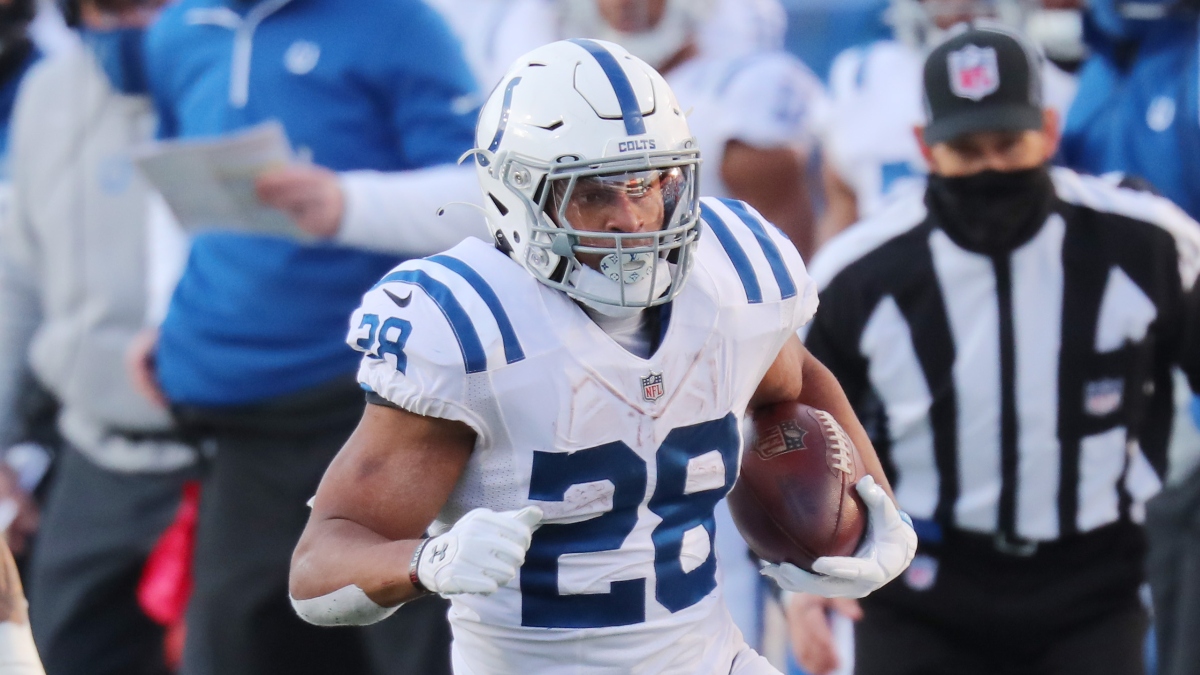 Timothy T Ludwig/Getty Images. Pictured: Jonathan Taylor
Timothy T Ludwig/Getty Images. Pictured: Jonathan TaylorOf the RBs in this tier, Taylor is typically coming off the board second, making him a fade for me — Colts’ QB Carson Wentz, LT Eric Fisher, LG Quenton Nelson and C Ryan Kelly are all nursing injuries, which is a considerable concern for Taylor.
More importantly, Nyheim Hines’ pass-catching role limits Taylor’s upside.
Takeaway: Target all RBs in Tier 4 except for Taylor
Tier 5
Joe Mixon (CIN)
Saquon Barkley (NYG)
Antonio Gibson (WAS)
Without Giovani Bernard eating into his passing-down work, Joe Mixon will be a true workhorse back. He has top-five upside as long as he can stay healthy.
Saquon Barkley (ACL recovery) is a risky first-round pick considering he may not even be active for Week 1. Either way, he’s going to be eased in and won’t be 100% until October. Monitor my updated Top 150 Big Board to see where I stand on Barkley, as it will change daily. As of writing on Aug. 11, Barkley would need to fall to me in the middle of Round 2 before I would consider biting.
It was remarkable how polished Antonio Gibson looked as a rookie, considering he was still learning the position. The most straightforward path to hitting his ceiling in Year 2 is an expanded role in the passing game. As a former wide receiver, it’s a skill set that’s already part of his repertoire.
J.D. McKissic is the only hurdle standing in Gibson’s way of top-five upside.
Takeaway: Avoid Barkley at his ADP. Mixon and Gibson have a green light.
Tier 6
Clyde Edwards-Helaire (KC)
Najee Harris (PIT)
Chris Carson (SEA)
D’Andre Swift (DET)
David Montgomery (CHI)
The CEH hype train ended up pushing his ADP into Round 1 last season. Unfortunately, he ended up falling well short of expectations, but I’m optimistic he’ll bounce back in Year 2 — he’s still the lead back in the most explosive offense in the league.
Najee Harris, meanwhile, may struggle in terms of efficiency while playing behind one of the worst offensive lines in Pittsburgh. But volume is king for RBs in fantasy, and he will be the Steelers’ true workhorse back starting in Week 1.
For the third straight season, Chris Carson is my favorite RB2 to target at his ADP. He should thrive in new offensive coordinator Shane Waldron’s up-tempo scheme. The only downside with Carson is that he’s injury-prone due to his violent running style.
D’Andre Swift is the first back taken that could end up in a frustrating Running Back By Committee (RBBC) with Jamaal Williams. However, Swift is talented enough to roll the dice at his ADP.
Montgomery took advantage of a Bounty-soft schedule in Weeks 12-17 last season and ended up posting RB2 overall numbers. The market is not taking the bait, though, and is instead drafting him in the RB17-18 range. I’m right in line with the market, making him an excellent pick at his ADP.
Takeaway: All five backs offer high-end RB2 value and should be targeted at their ADP. Carson is usually the last RB of this Tier to come off the board, making him the best value.
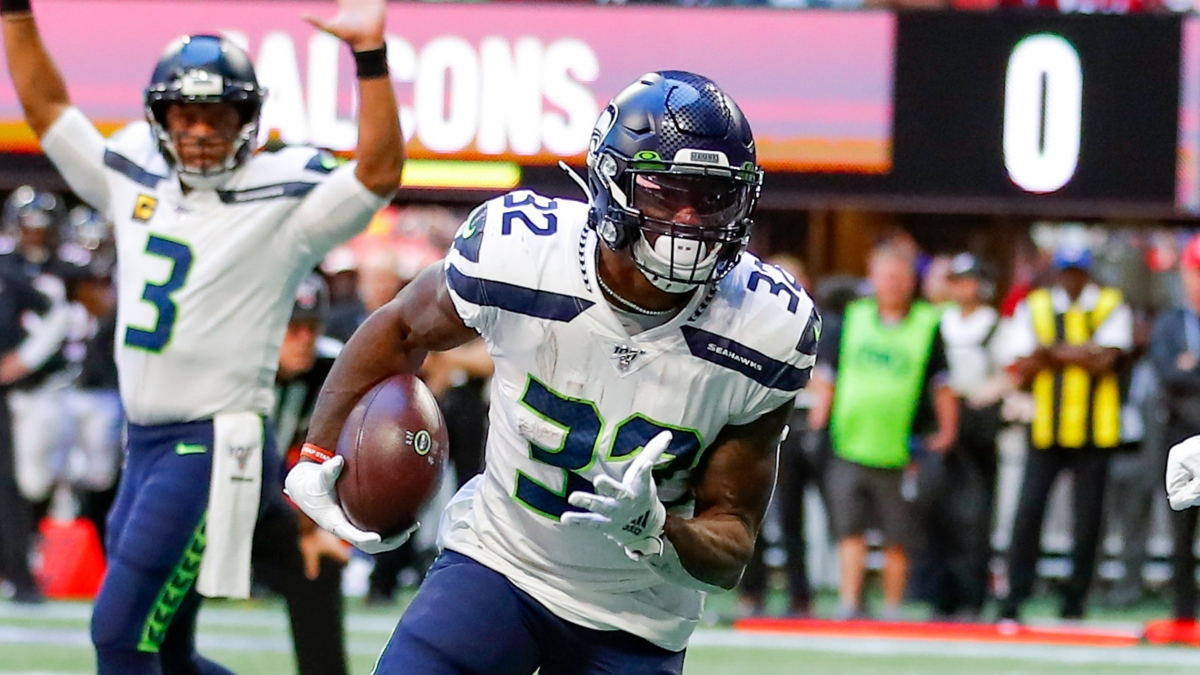 Todd Kirkland/Getty Images. Pictured: Chris Carson
Todd Kirkland/Getty Images. Pictured: Chris CarsonTier 7
J.K. Dobbins (BAL)
Josh Jacobs (LV)
Miles Sanders (PHI)
Darrell Henderson (LAR)
There’s a growing number of people referring to this as the “dead zone” at RB. First off, “Frozen Pond” is a much better analogy! Second, I don’t consider this a dead zone at all — the RB2 Tier is excellent this season.
Do you know which RBs were being drafted in this range last year? James Conner, David Johnson, Le’Veon Bell, Melvin Gordon and Todd Gurley. Now that is a “dead zone”! It’s easy to say that Tier was a massive bust a year later, but I made it pretty clear then that I didn’t want to end up with any back in it.
Sure, J.K. Dobbins, Josh Jacobs and Miles Sanders may have lower ceilings due to their limited role in the passing game. But all three backs are talented, still in their prime, and offer RB1 upside as a result.
Usually, we aren’t lucky enough to have backs of this caliber fall to us as low-end RB2s.
Darrell Henderson is penciled in as the Rams’ lead back for 2021 following Cam Akers’ season-ending injury, though Henderson’s value will take a hit if the Rams add a veteran to form more of a RBBC. (I’m already factoring in those chances into his rank here.)
Takeaway: Usually, the low-end RB2 Tier carries hidden risk, leading me to avoid it — but that isn’t the case this season. I’m willing to target any of these backs at their ADP if it’s time to address RB in a given draft.
Tier 8: The ‘Frozen Pond’
Mike Davis (ATL)
Kareem Hunt (CLE)*
Travis Etienne (JAX)
Myles Gaskin (MIA)
Chase Edmonds (ARI)
*Hunt is not part of the ‘Frozen Pond’
This tier is much closer to what I would describe as the “Frozen Pond.”
As a refresher: The Frozen Pond describes running backs who, on the surface, appear to be solid starters but may quickly become unplayable as part of a frustrating RBBC or even become the backup.
Mike Davis showed he could post RB1 numbers as a starter in place of the injured CMC last season. Davis parlayed that into a two-year deal with the Falcons and is expected to be their Week 1 starter. However, he’s far from a slam dunk, considering he’s a 28-year-old journeyman entering his seventh season. He should be able to hold off a weak RB depth chart on the Falcons, but there is a chance he was a one-year wonder.
Kareem Hunt is not part of the Frozen Pond. He should return value at his ADP even if Nick Chubb were to play all 17 games, and would offer top-five upside if Chubb were ever to miss time.
These are the types of RBs I love targeting.
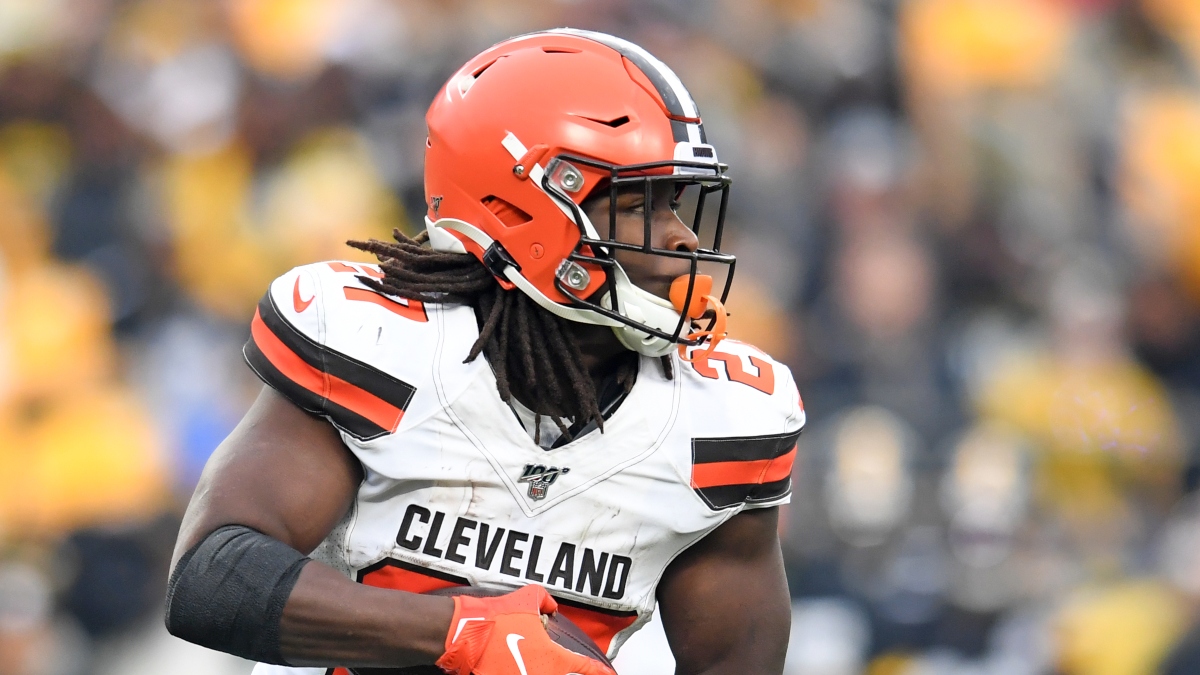 Nick Cammett/Diamond Images via Getty Images. Pictured: Kareem Hunt
Nick Cammett/Diamond Images via Getty Images. Pictured: Kareem HuntThe Jaguars decided to select Travis Etienne in the first round of the 2021 NFL Draft despite having an excellent back in James Robinson. There’s uncertainty about how new head coach Urban Meyer will handle this RBBC — he has gone as far as lining Etienne up as WR in training camp.
I was much more comfortable drafting rookies Jonathan Taylor and D’Andre Swift in this range last year, but I am more cautious when it comes to Etienne.
Myles Gaskin is the best bet to push RB1 value in this Tier. When healthy, he operated as the Dolphins’ true workhorse back last season. They opted not to draft a RB until the second round (Gerrid Doaks), which can be viewed as a vote of confidence in Gaskin. However, Gaskin is far from a slam dunk.
He is a seventh-round talent who could struggle behind what should be a below-average offensive line. Head coach Brian Flores showed he isn’t afraid of benching players when they struggle (see: Tua Tagovailoa). After all, Flores does come from the Bill Belichick coaching tree, where a frustrating 2-3 way RBBC is normal.
There is a chance either Salvon Ahmed or Malcolm Brown could make spot starts over a healthy Gaskin.
Chase Edmonds would carry high-end RB2 upside if James Conner were ever to miss time. Considering Conner has never played more than 14 games in a season and is still recovering from offseason toe surgery, Edmonds has sneaky value at his ADP.
Takeaway: ‘Frozen Pond’ RBs would be on my ‘Do Not Draft’ list most season. However, with the RB2 Tier being so strong this year, I’m OK targeting this tier at ADP. Of course, you wouldn’t want to have any of these backs as your RB2. But since these should be your RB3/Flex, I love the upside you get with this tier.
The position also takes a massive 20-point drop-off heading into the next tier, making it critical to have three RBs before this tier is off the board.
Tier 9
James Robinson (JAX)
Melvin Gordon (DEN) (E)
Javonte Williams (DEN) (L)
Damien Harris (NE)
Leonard Fournette (TB)
Michael Carter (NYJ) (L)
Kenyan Drake (LV)
Raheem Mostert (SF) (E)
Trey Sermon (SF) (L)
Zack Moss (BUF)
Ronald Jones II (TB)
David Johnson (HOU)
James Conner (ARI) (E)
* (E) = Early-season value; (L) = Late-season value
Things start to get messy here.
This tier is primarily made of up RBs who are either the lead or trailing back in a strict RBBC. Each would have a path to RB1/2 upside if their RBBC counterpart were ever to miss time — consult my RB Upside Ratings for the best way to handle that aspect.
The best way to view this tier is to identify which backs will offer early-season value and which will see their role increase as the season goes on, which is why I’ve identified backs who fit either criteria.
Melvin Gordon will likely open the season as the Broncos’ lead back. However, it’ll only be a matter of time before second-round rookie Javonte Williams makes this a 50/50 timeshare or takes over as the lead back.
Michael Carter is essentially a Clyde Edwards-Helaire clone, and I like the idea of drafting Carter as my RB3/4 to stash on my bench to begin the season. He’ll be part of a murky 3-4 way RBBC to start the season but should separate himself from the pack by mid-season.
Raheem Mostert will be the 49ers’ Week 1 starter, but they probably didn’t spend a 2021 third-round pick on Trey Sermon to be Mostert’s backup for too long. Sermon’s physical running style is a better fit with rookie quarterback Trey Lance, so I could see Sermon taking over as the lead back once Lance becomes the team’s starter.
Takeaway: Target (E) or (L) backs based on where you are at with RB depth at this point in the draft. If you are thin at RB or have a player like Barkley who may not play Week 1 and need a back who can start the opening week, target (E) backs.
If you’re beginning to draft RBs for your bench, target (L) type backs. You won’t need to rely on these backs early in the season anyway and can afford to wait for their stock to go up as the season unfolds.
Tier 10
Gus Edwards (BAL)
Jamaal Williams (DET)
Devin Singletary (BUF)
Latavius Murray (NO)
A.J. Dillon (GB)
These are all high-upside backups who will provide RB1/2 value if their team’s starter were ever to miss time. However, they sometimes command enough touches even when the starter is healthy to offer RB3/Flex value.
I love snagging one of these backs as a cheap high-floor, high-ceiling option for my bench — they tend to come in handy when bye weeks and injuries start to hit.
Takeaway: Target at their ADP
Tier 11
High-Upside Backups
Tony Pollard (DAL)
Alexander Mattison (MIN)
Both Pollard and Mattison would offer league-winning upside if their team’s starter were ever to miss significant time with injury. If you draft either Elliott or Cook, it would be a good idea to stash their backup as insurance.
High Floor Third-Down Backs
Nyheim Hines (IND)
J.D. McKissic (WAS)
James White (NE)
These third-down backs are worth targeting if you’re thin at RB and need a high-floor option who can provide you a handful of points in a pinch, especially in PPR formats.
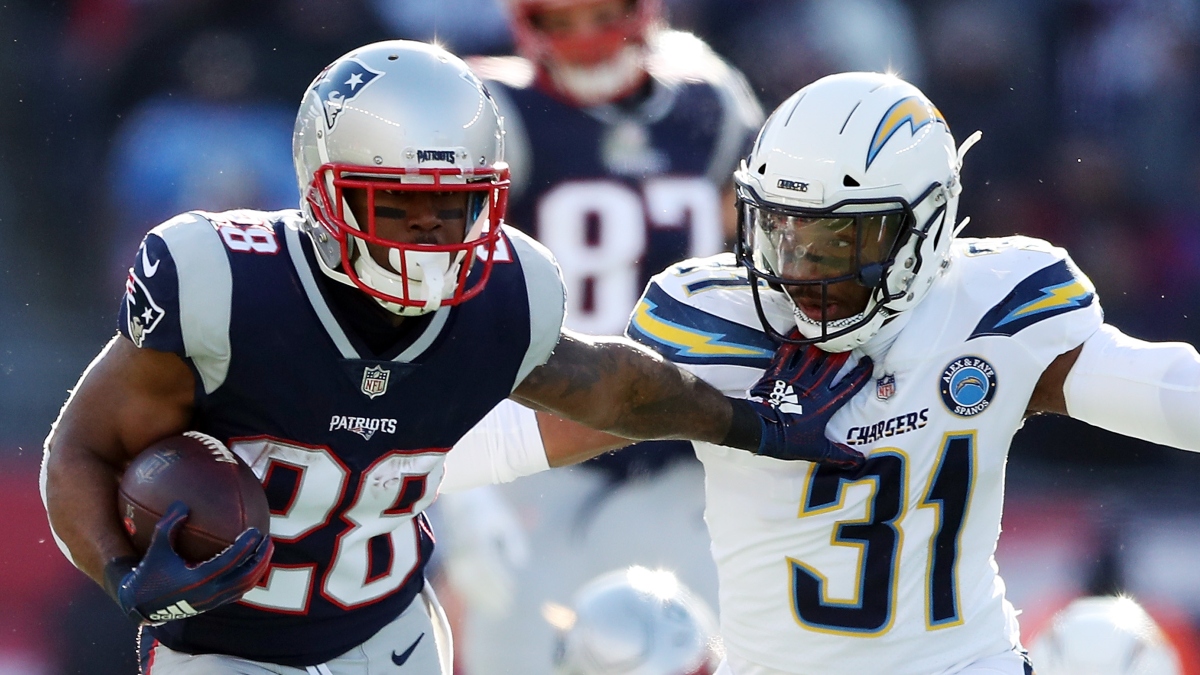 Adam Glanzman/Getty Images. Pictured: James White
Adam Glanzman/Getty Images. Pictured: James WhiteTier 12
High Upside Backups/Handcuffs
Tevin Coleman (NYJ)
Phillip Lindsay (HOU)
Rashaad Penny (SEA)
Chuba Hubbard (CAR)
Darrel Williams (KC)
Devontae Booker (NYG)
Samaje Perine (CIN)
High Floor Third-Down Backs
Tarik Cohen (CHI)
Giovani Bernard (TB)
Kenneth Gainwell (PHI)
I’m only highlighting a handful of backs here as rankings aren’t as important once you get to this part of the draft. Instead, refer to my RB Upside Ratings for a more in-depth look at how I treat this part of the draft.
Tier 13: Lottery Picks
Free Agents
Adrian Peterson (FA)
Le’Veon Bell (FA)
Todd Gurley (FA)
Duke Johnson (FA)
High-Upside Backups or Third-String Backs
Darrynton Evans (TEN)
Xavier Jones (LAR)
Jeffery Wilson (SF) (IR)
Justice Hill (BAL)
Jerick McKinnon (SF)
Rhamondre Stevenson (NE)
Wayne Gallman (SF)
Michael Boone (DEN)
Unless you are in a league that requires you to draft a K/DEF, you should skip those positions and instead draft 1-2 RB lottery picks instead. We’re still weeks away from Week 1, and there could be significant injuries, suspensions, etc. that vault any one of these backs into fantasy relevance.
You can draft one of the remaining free agents and hope they end up signing with a team that has a starting job open up. I also highlighted RBs you could get in the last round that are an injury or two away from offering “league-winning” upside.
The idea is to hold onto these lottery tickets (instead of a K/DEF) until we get into Week 1. At that point, you can drop them to add your Week 1 K or DEF off the waiver wire. Of course, you shouldn’t draft Jeff Wilson, but since he will begin the season on the IR, he’s worth adding to stash on your IR for free. There’s zero downside in adding a player who could potentially become a RB3/Flex option in the second half of the season.

